If you spot a small green bug that bites, don’t panic because a lot of them are harmless. Some of them are plant eaters or herbivores, while the carnivorous ones eat small insects only.
Most of them have interesting characteristics, such as being able to change their colors depending on their surroundings.
So, what are the little green bugs that bite? Among the tiny green bugs that bite are pale green assassin bugs, ambush bugs, green leafhoppers, six-spotted green tiger beetles, sweat bees, and dogbane leaf beetles. Although their bites are not dangerous, one of them releases poison when ingested or threatened.
In general, these little green bugs are not interested in biting humans. However, their bites can be painful as a way of protecting themselves.
But still, you should know how to identify them and understand whether they are pests or beneficial insects. In this guide, you will learn more about them and how to get rid of them.
Top 6 Tiny Green Bugs That Bite
1. Pale Green Assassin Bugs
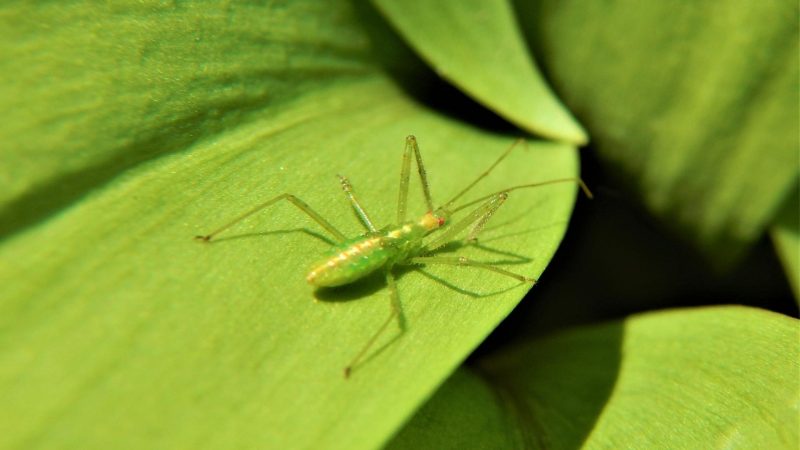
Scientifically known as Zelus luridus, pale green assassin bugs belong to the family Reduviidae and in the order Hemiptera. The name “luridus” came from the term “lurid,” which means ghastly or gruesome.
These true bugs are among the nearly 200 species of assassin bugs that are commonly found in North America.
Despite being vicious predators, male pale green assassin bugs are excellent fathers. After the female lays eggs on a leaf or twig, the male stands directly over them and guards them until they are hatched.
They bravely attack other insects that get close to the eggs. Interestingly, most males also bring food to their young.
What Do Pale Green Assassin Bugs Look Like?
As the name implies, the body of pale green assassin bugs is green. However, their wings can be brown or tan, while their leg joints are usually reddish. They have elongated bodies, narrow heads, and beak-like mouthparts.
Male adults are usually about 14 mm long, while females are a bit bigger at around 16 mm long.
What Do Pale Green Assassin Bugs Eat?
Like other assassin bugs, pale green assassin bugs eat ants, aphids, beetles, flies, wasps, and other small insects. They usually rest on leaves and stalk an insect passing by.
Then, they grab it using their forelegs and inject venom before sucking its body fluid. If food is unavailable, these tiny green bugs eat each other.
Are Pale Green Assassin Bugs Harmful to Humans?
Generally speaking, assassin bugs are not aggressive and don’t attack humans. However, they may bite humans when mishandled or accidentally pressed.
A pale green assassin bug bite is quite painful but not dangerous. But unlike kissing bugs, pale green assassin bugs don’t transmit Chagas disease.
How to Get Rid of Pale Green Assassin Bugs Naturally?
Pale green assassin bugs are considered beneficial insects in gardens, not pests. Despite their name and creepy appearance, you should avoid killing them.
But then, they should remain outdoors, and you must not allow them to enter your house. If you notice their presence, here are some ways to get rid of them:
- Use a vacuum cleaner or a broom to drive them off. Just make sure you don’t touch them with bare hands.
- Eliminate all their food sources, and they will go back to their natural habitat.
- Avoid indoor plants such as alfalfa and marigold. Assassin bugs don’t damage plants, but they love them because of the insects.
- To prevent them from coming back, seal all gaps and cracks around your house.
2. Ambush Bugs
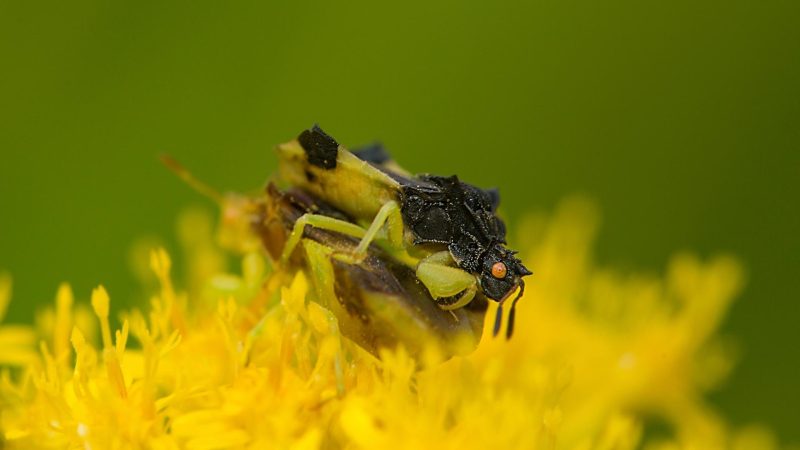
Scientifically known as Phymata Americana, ambush bugs are cousins of assassin bugs. There are about 300 ambush bug species worldwide, and most of them are in Asia and North America.
They patiently wait for their prey to arrive and then, suddenly grab them with their thick forelegs, hence the name.
Ambush bugs have wings, but they rarely fly. Instead, they prefer crawling around plants as slowly as possible. They are mostly found in flowering plants such as goldenrods (Solidago), thistles, and other composite flowers.
But in general, they stay in open and sunny areas, including fields, parks, prairies, and roadsides.
What Do Ambush Bugs Look Like?
Ambush bugs are about 8-12 mm long, with a short head, stout body, long 3-segmented beak, and thickened forelegs similar to those from praying mantis.
Most of them are brown but can change to brown or yellow, depending on their background. Nonetheless, some species can be black, red, gray, and orange.
What Do Ambush Bugs Eat?
Ambush bugs are predators of small insects such as bees, beetles, bumblebees, butterflies, flies, moths, and wasps. Amazingly, they can also capture and eat insects bigger than them.
After grabbing their unsuspecting prey, ambush bugs inject a poison that paralyzes them instantly and then sucks out their body fluids.
Are Ambush Bugs Harmful to Humans?
Ambush bugs can be harmful to humans but not dangerous. In fact, they will only bite people if they are heavily threatened. Ambush bug bites are extremely painful and may cause swelling of the skin.
Fortunately, they don’t carry diseases, and their venom cannot paralyze humans. Their bites rarely need medication.
How to Get Rid of Ambush Bugs Naturally?
Like assassin bugs, ambush bugs are also garden friends, so you should not control them outdoors. But sometimes, they may enter your house and can be nuisances.
To get rid of ambush bugs, you don’t need to use insecticides. Instead, eliminate or reduce the things that attract them. Here are some of them:
- Ambush bugs are attracted to artificial light at night because insects are also attracted to it. Turn them off at night or transfer them to your garden.
- Avoid putting plants near your door and windows.
- Remove rock piles and wood around your house.
- If some of them are already inside, simply vacuum them.
3. Green Leafhoppers
Scientifically known as Cicadella viridis, green leafhoppers are in the order Hemiptera. Some leafhopper species can be yellow, brown, or mottled, but most of them are green. Cicadellidae is considered one of the largest families of insects in the world, and lots of new species are still being discovered every year.
Green leafhoppers are known for their camouflage ability, which means they can change their color to blend with their surroundings to hide from predators.
Aside from that, they can jump fast and walk sideways, especially when disturbed. These little green bugs are commonly found on the underside of leaves.
What Do Green Leafhoppers Look Like?
Green leafhoppers are about 1/4-inch long, with pointed heads, piercing-sucking mouthparts, a slender, wedge-shaped body, and red-tipped antennae.
This is why they are sometimes mistaken for aphids and Lygus bugs. Later-stage leafhoppers nymphs look like adults, except that they are smaller and have shorter wings.
What Do Green Leafhoppers Eat?
Green leafhoppers feed on a wide variety of fruits, vegetables, flowering plants, and woody ornamental hosts. They may also eat rice plants that are being fertilized with high levels of nitrogen. They feed by sucking chlorophyll from the leaves and prefer lateral leaves instead of middle leaves and leaf sheaths.
Are Green Leafhoppers Harmful to Humans?
Green leafhoppers are generally not harmful to humans. Although there were earlier reports of green leafhoppers biting people, they were very rare and are only accidental. A green leafhopper bite is not dangerous and usually does not require medical attention. Nonetheless, these little green bugs are agricultural pests.
How to Get Rid of Green Leafhoppers Naturally?
Green leafhoppers are quite hard to control because of their small size and mobility. They can damage plants and are also vectors of viral diseases of rice such as tungro and yellow dwarf. But since most pesticides contain ingredients that can harm your plants, here are some natural ways to get rid of leafhoppers:
- For rice crops, control the weeds and avoid applying too much nitrogen.
- To help reduce leafhoppers, perform crop rotation or plant non-rice crops during dry seasons.
- For garden plants, use organic products such as Safer Brand Insect Killing Soap , which also kills aphids and earwigs.
- For organic gardening, you can use a dormant spray such as Bonide Ready to Use Neem Oil .
- Place some specific natural enemies of leafhoppers. This includes lacewings, lady beetles, and ladybugs. If you need lots of them, here are 1,500 Live Ladybugs from ELLASSAY .
4. Six-spotted Green Tiger Beetles
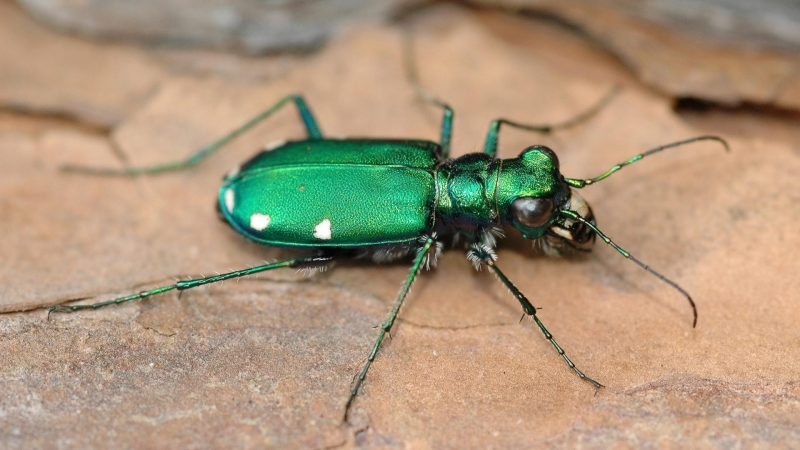
Scientifically known as Cicindela sexguttata, the six-spotted green tiger beetle is one of the 147 tiger beetle species common in North America. They are most active from April to early July. This small green bug is a relative of the green tiger beetles (Cicindela campestris), which are widely distributed across Europe.
Astonishingly, tiger beetles can run and fly so fast that their eyes can’t keep up, making them temporarily blind. But because of this, they can only run short distances at a time. These active creatures are solitary bugs and usually live in sandy soils, open pine forests, woodland edges, and sunny areas.
What Do Six-spotted Green Tiger Beetles Look Like?
As the name implies, six-spotted green tiger beetles are striking metallic green and have six small white or yellowish spots at the edges of their wing covers. But then, some of them have less than six spots or have no spots at all. They are 0.4-0.6 inches (10-14 mm) long, with large eyes and long, skinny legs.
What Do Six-spotted Green Tiger Beetles Eat?
Six-spotted green tiger beetles feed on various insects such as ants and caterpillars, as well as other arthropods, including spiders. These ferocious predators grab their prey with their huge violent-looking mandibles and very powerful jaws. Both adults and larvae are carnivores and eat invertebrates.
Are Six-spotted Green Tiger Beetles Harmful to Humans?
Six-spotted green tiger beetles are not harmful to humans. Nevertheless, they may bite people who will mishandle or threaten them. Their bites are not dangerous, although they can be painful. These beetle species also don’t carry diseases. Meanwhile, some species release cyanide but cannot make you sick.
How to Get Rid of Six-spotted Green Tiger Beetles Naturally?
Tiger beetles are beneficial insects and one of the best-studied non-pest insects in the world. And because their presence or absence can help biologists study the quality of an environment, they are considered important components of the ecosystem. Once indoors, they will usually leave on their own, so don’t kill them.
5. Sweat Bees
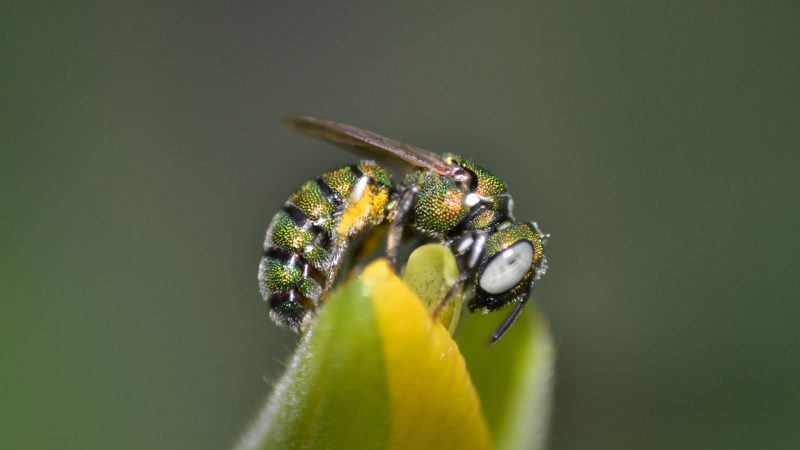
Scientifically known as Halictidae, sweat bees are in the order Hymenoptera, which includes ants, hornets, sawflies, and wasps. Their name came from the fact that one genus (Lasioglossum) is very attracted to perspiration, which contains salt and moisture. Most of them are solitary, but some can be social.
Also called halictid bees, sweat bees are widespread globally and are commonly found in temperate regions. Nearly all species build nests underground, while some of them nest in rotten wood. Females dig burrows in the soil, either vertical or flat surfaces, where they build cells for their eggs and the developing larvae.
What Do Sweat Bees Look Like?
Most sweat bees have lime green bodies, while some are metallic black, blue, or purple. Depending on the species, they are about 1/4-3/4 inches long. Males and females look the same, except that the bodies of the females are more slender. Females also have long, dense hairs (scopa), which they use for carrying pollen.
What Do Sweat Bees Eat?
Most sweat bee species feed on flower nectar and pollen, but they also eat honeydew. Females collect huge loads of pollen and bring them to their nests to feed their young, making them great mothers. In some cases, this tiny lime green bug includes salt in its diet, especially if a sweating person is passing by.
Are Sweat Bees Harmful to Humans?
Sweat bees are not harmful to humans and pets. Like other bee species, females may sting people who will try to disturb their nests or threaten them. Fortunately, they are also not aggressive and rarely attack humans. Sweat bee stings are only mildly painful, and they usually don’t need medical care.
How to Get Rid of Sweat Bees Naturally?
Being very active pollinators, sweat bees play a very important role in the health and integrity of our natural habitats. Pollination is essential in agriculture because, without it, plants cannot produce the seeds and fruits that we need. But since sweat bees can be pests indoors, here are some ways to get rid of them naturally:
- During summer, increase ventilation inside your house.
- Mix a few drops of peppermint extract and water and spray the mixture to your skin. If you don’t have peppermint, you can use Mighty Mint Insect and Pest Control Peppermint Oil .
- Alternatively, you can use a DEET-free insect repellent such as Repel Lemon Eucalyptus Natural Insect Spray .
- For minor infestations, trap them using eco-friendly bee traps, such as .
- Try adding some layers of mulch on the ground to make the soil thicker. In doing so, sweat bees will have a hard time creating underground nests.
6. Dogbane Leaf Beetles
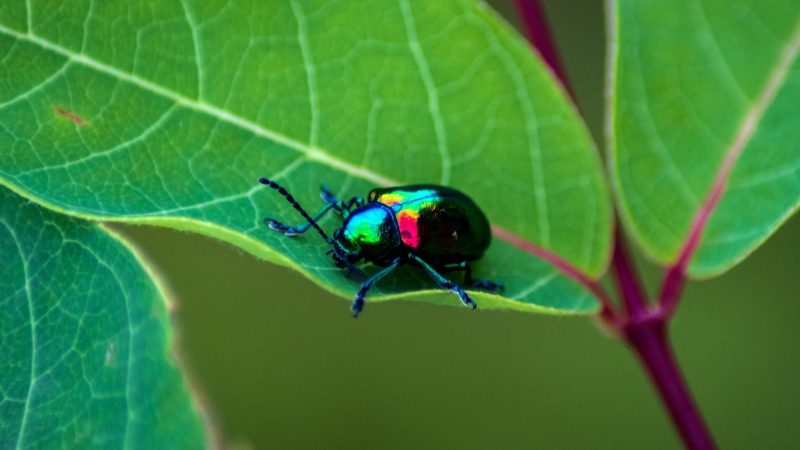
Scientifically known as Chrysochus auratus, dogbane leaf beetles belong to the family Chrysomelidae which is one of the largest families of beetles. They are commonly found in their host, the dogbane plant, hence the name. Also called Indian hemp, this perennial plant is highly toxic to dogs and humans.
Dubbed as spreading dogbane, this poisonous flowering plant is widespread across the United States, especially in the eastern part.
They spread easily in open areas such as fields, lakeshores, railroad tracks, and roadsides. Wherever this plant grows, expect that there is also a presence of dogbane leaf beetles.
What Do Dogbane Leaf Beetles Look Like?
Dogbane leaf beetles are mostly shiny green or blue-green with a copper shine on their elytra. Depending on your viewing angle, they can also be red or gold. They can grow between 8 and 11 mm (0.31 and 0.43 inches) long.
Their head and thorax have deep holes, while each of their long antennae has 12 joints.
What Do Dogbane Leaf Beetles Eat?
Using their flat mouthparts, dogbane leaf beetles eat the sap of dogbane plants and milkweeds, which contain a cardiac poison called cardenolides.
Amazingly, dogbane leaf beetles can ingest the sap without getting poisoned. They use it as a defense mechanism against their predators just like the dogbane plants do.
Are Dogbane Leaf Beetles Harmful to Humans?
Dogbane leaf beetles can be harmful to humans, but only if ingested. Once disturbed, they will release cardenolides which when high concentrations are eaten may lead to serious dysrhythmias and cardiac arrest, especially in dogs. Among all the green bugs that bite, dogbane leaf beetles are the most dangerous.
How to Get Rid of Dogbane Leaf Beetles Naturally?
Dogbane leaf beetles are the main pests of dogbane plants and milkweeds, but sometimes, they can also damage other plants. Despite their gorgeous looks, you and your dogs may get sick once ingested.
But because you want to avoid using pesticides, here are some natural ways to get rid of dogbane leaf beetles:
- Avoid planting dogbane plants and milkweeds in your garden. But if you do, place a barrier so your dogs cannot reach them.
- Spray soapy water directly on them. But because these leaf beetles give off the poison, don’t touch them or go very near them.
- Since leaf beetles are most active outdoors in the spring and summer, try planting in the latter part of spring.
- If leaf beetles are inside your house, especially during colder months, scoop them carefully or use a vacuum cleaner.
Summary
As you have learned from the article, the beneficial qualities of these tiny green flying bugs that bite far outweigh their negative traits. This is why you should avoid killing them. To avoid a self-defense bite, brush them away very gently once they land on your skin. But if they are far away from you, just ignore them.
List of Sources
Zelus luridus – A Common Assassin Bug. Colorado State University – College of Agricultural Science.
Ambush Bugs. Missouri Department of Conservation.
Leafhoppers. University of California Agriculture & Natural Resources.
Halictid Bees (Sweat Bees). Missouri Department of Conservation.
Dogbane Leaf Beetle (Family Chrysomelidae). (2010). University of Wisconsin-Milwaukee.
- How to Get Rid of Copperheads | Practical Guide - August 27, 2023
- How to Get Rid of Corn Snakes | What Makes Them Aggressive? - August 27, 2023
- How to Get Rid of Alligators | Safety Measures and Removal Methods - July 16, 2023

